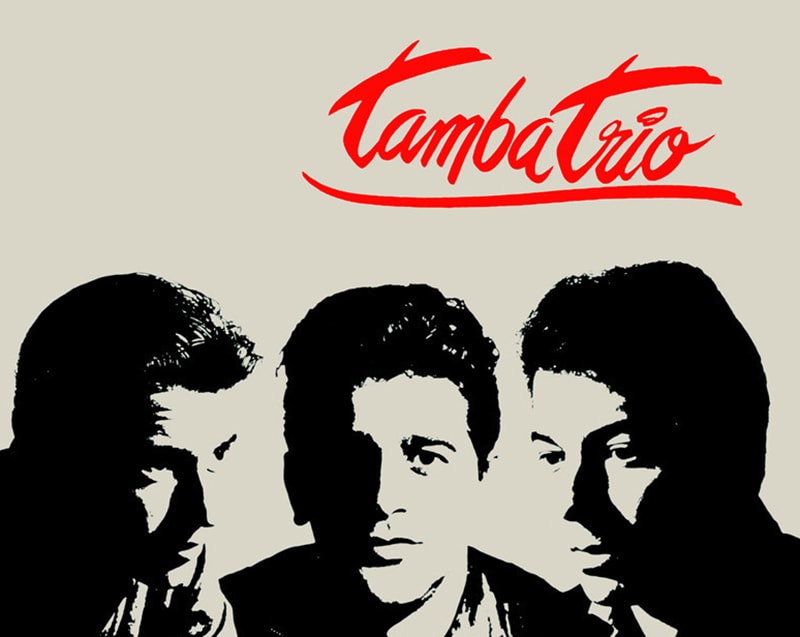When the Brazilian music of the 1960s comes to mind, we commonly think of the many composers and artists who were popular in bringing the samba, bossa nova and Brazilian music to the world. Names like João Gilberto, Antonio Carlos Jobim, Luiz Bonfa, Laurindo Almeida and Sergio Mendes were familiar to many. Equally important in Brazil during the bossa nova movement, but often overlooked, was the work of classically-trained pianist and composer Luiz Eça, who was also known for being part of the Tamba Trio. Featuring Eça’s brilliant piano performances and his trio partners’ ability to play and sing tightly in sync, the trio’s recordings were unlike their contemporaries, who either sang, or played instruments. The Trio’s members did both, simultaneously. The earliest lineup of the Tamba Trio on record featured leader Luiz Eça on piano, Bebeto (Bebeto Castilho) on flute and bass, and Hélcio (Hélcio Milito) on drums and percussion. (The group members, aside from Eça, were usually referred to by their first names or nicknames.) From about 1966 onward, Ohana (Rubens Ohana) took over on drums and percussion. Their signature tune “Tamba” led off their 1962 debut album, Tamba Trio.
One of Tamba Trio’s first hits was a recording of Jorge Ben’s “Mas Que Nada,” a few years before Sérgio Mendes would record his signature version with Brasil ’66. This song is from their 1963 album Avanço.
Also featured on Avanço, the Trio would also record one of the first performances of “Garota de Ipanema.” httpv://www.youtube.com/watch?v=fb2_pzSwggk Luiz Eça & Cordas was an album that featured Eça’s piano and string arrangements. His fellow Tamba Trio members back him up on the recording, but only instrumentally. Here is “Imagem,” which was also an alternate album title for reissues.
In 1964, the Tamba Trio provided backing for the debut album A Música de Edu Lobo por Edu Lobo by newcomer Edu Lobo, who would soon become one of the voices of the MPB (Musica Popular Brasileira) movement, where bossa nova was cast aside in favor of songs echoing Brazil’s growing social consciousness. The Trio provides their typically brilliant backing to Lobo’s album. Among others, some of Lobo’s most famous tunes would appear on this album and become standards in the following years: “Chegança,” “Reza,” “Arrastão,” and “Borandá.” In this recording, the lead vocal and guitar are Edu Lobo, while the remaining instruments, voices and string arrangement are courtesy of Eça and the Tamba Trio.
One of the earliest albums recorded for Creed Taylor’s CTi label (at first an imprint of A&M Records), was We and the Sea, an album by Tamba 4, essentially the Tamba Trio with an added member. The fourth member is Dorio (Dorio Ferreira) who plays guitar, and bass on all but two of the tracks on the album. This album was perhaps the most adventurous in both the Trio’s catalog as well as the A&M/CTi label. The album opener (featured below) was “O Morro” (“The Hill”), in an arrangement that wanders between moods and numerous variations; the equally stunning “Consolaçao” is also worth hearing, as is one of Eça’s most beautiful (and perhaps best known) compositions, “Dolphine.”
The follow-up album Samba Blim was not quite as adventurous, yet the Tamba Trio spirit was still evident in their take on Edu Lobo’s “Reza,” making it one of the highlights of a somewhat sleepy album. The accelerando ending in particular is noteworthy.
In 1969, a third Tamba 4 album was rumored to have been recorded but was never released. (This was around the time Creed Taylor left A&M.) The only music issued was a promotional 45 RPM single containing the tunes “California Soul” and “No Onda do Berimbau.” In 2019, the album California Soul was finally released. As with all of the A&M/CTi albums, this one featured Sam Antupit’s bold white border design, with a previously unseen Pete Turner photo used for the jacket. Musically it’s hardly essential, but it is nonetheless a fun listen. What gives the album a different feel is that Eça plays electric piano throughout the album. All the horn arrangements backing Tamba 4 were penned by Eça as well. (Note that the digital release of this album uses a different photo not taken by Pete Turner.) Bebeto takes a lead vocal on the Milton Nascimento tune “Travessia” (also known as “Bridges”).
Confusingly, a 1970 album released in Brazil was credited to Tamba 4, but was an offshoot project featuring Bebeto, Ohana and Dorio with Laercio de Freitas on piano; Luiz Eça was not involved in this recording. In the mid 1970s, however, the Trio released two more albums featuring the original 1962 lineup of Eça, Bebeto and Hélcio. The following song by Ivan Lins, “3 Horas de Manhã,” is from the 1975 RCA album Tamba Trio.
A Selected Tamba Trio Discography
Most of these titles were reissued on import CD, and some are still available despite being discontinued. The easiest to find are the three A&M/CTi releases. For the earliest Tamba Trio recordings, your best bet for a compilation may be the 1997 Classics 2-CD set, or the single 1999 CD Millennium: 20 Músicas do Século XX. The group had four original albums entitled Tamba Trio; rest assured, they are all different recordings. Tamba Trio: Tamba Trio (1962, Philips) Tamba Trio: Avanço (1963, Philips) Tamba Trio: Tempo (1963, Philips) Edu Lobo Com A Participação Do Tamba Trio - A Música De Edu Lobo Por Edu Lobo (1964, Elenco) Luiz Eça: Luiz Eça & Cordas (1965, Philips) Tamba Trio: Tamba Trio (1966, Philips) Tamba Trio: Tamba Trio (1968, Philips) Tamba 4: We and the Sea (1968, A&M/CTi) Tamba 4: Samba Blim (1968, A&M/CTi) Tamba 4: California Soul (1969; released 2019, A&M/CTi) Tamba Trio: Tamba (1974, RCA Victor) Tamba Trio: Tamba Trio (1975, RCA Victor)


